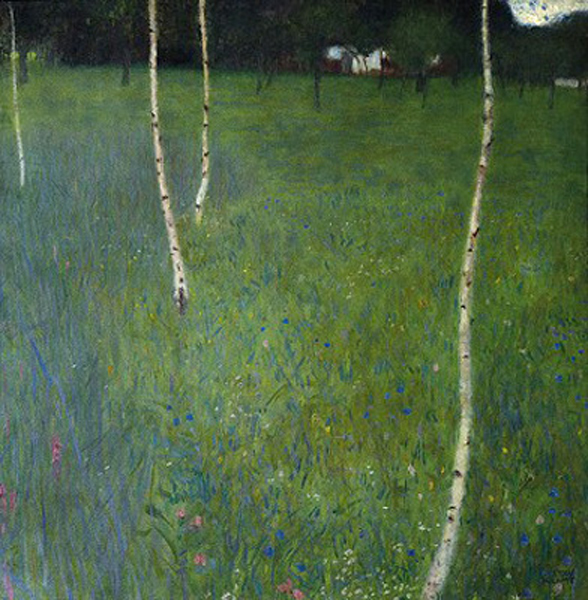The painting, Farm House With Birches (1900), illustrates the artists Gustav Klimt's intercut technique used to portray the presence of greenery within his work.
Gustav is a prominent painted with the 19th century who used an array of techniques including Realism, Impressionism and Byzantine mosaics.
The calm piece is a part of Klimt's garden series, where upon his summer away to the countryside of Austria away from the city, the artist was inspired by nature in its essential form. These works include Farm Garden with Sunflowers (1913), Country House on Attersee (1901), Church in Unterach Attersee (1901), Attersee (1900), and Farm House in Upper Austria (1911). These paintings cover an array of simple styles with a flattened landscape, blurring shapes together.
Within a letter Gustav Klimt wrote to his friend Marie Zimmermann, the artist mentioned the painting, Farm House With Birches. Paintings of birch trees gained a rapid success for painters as it illustrated the transition into spring and the new warmer season approaching. The artist has a detail oriented fascination for nature, and studied its every transition from seasons.
The painting is said to illustrate the transformation of the forest from winter into spring. The meadow is broken into three separate sections to manifest this transition through stages. Firstly it is covered by narrow reef shaped blue flower's seizing the plains, transitioning to the right as it fills with small white daisies, and eventually transcends into the horizon as a lush green meadow.
The colours used to light the floor of the painting and based on an array of potent green shades, paired with deep blues with a hinder of lavender to illustrate the reed growing. The meadow blends into a dark shade of green as it deepens into the forest.
The birch trees remain a classic theme within Klimt's work, where he also used the symbol in Birch Forest (1903). The difference within Farm House with Birches is the skinny silhouette of the tree, illustrating the young age of the classic plant.
Yet, as the tree is thin and young, it grows tall into the canopy with leaves sprouting. The background near the top of the painting is covered in shades of dark green blended together to illustrate the deep forest that forms. The viewer is able to locate a white and grey cabin or farmhouse in the centre of the forest. Alongside, the top right corner of the piece is illuminated through a clearing in the canopy to illustrate the sky.
The piece continues the classic garden theme of Klimt's work that had seized his style upon spending his summer's away in the countryside with his lover and friends. The array of elements within nature inspired Klimt to paint with an array of green shades, while incorporating pops of colours to bring life.
A focal point within Farm House With Birches are the few lavender colour flowers that flourish out of the ground near the bottom left of the piece. These few pieces add a glimpse of colour to the landscape, while illustrating the transition into spring.




